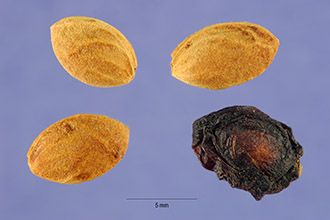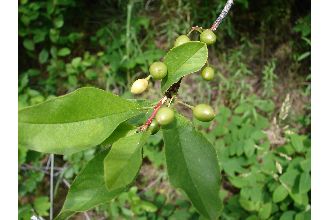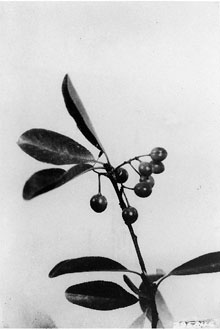Bitter Cherry
Scientific Name: Prunus emarginata (Douglas ex Hook.) D. Dietr.

| General Information | |
|---|---|
| Usda Symbol | PREM |
| Group | Dicot |
| Life Cycle | Perennial |
| Growth Habits | ShrubTree, |
| Native Locations | PREM |
Plant Guide
Uses
Ethnobotanic: The edible fruits are bitter and best used in jams. A green and dark gray dye was obtained from the fruits and leaves. The bark was used for making baskets that were watertight and resist decay (Moerman 1998). The thin outer bark was used to make mats, ropes, arrows, and as an ornament on bows (Ibid.). Several native North American tribes used bitter cherry to treat a variety of complaints. An infusion of the bark was used in the treatment of tuberculosis (Moerman 1998). A decoction of the root and inner bark was taken daily as a treatment for heart troubles (Ibid.). An infusion of the bark, combined with crab apple (Malus spp.), was used as a cure all tonics in treating colds and various other ailments (Ibid.). An infusion of this species’ rotten wood was used as a contraceptive. Wildlife: Prunus emarginata is a valuable species for elk, mule deer, and black bears. The fruits are eaten by small mammals, rodents, and various birds. This species is preferred by sheep and cattle. Agroforestry: Bitter cherry is used in forested riparian buffers to help reduce stream bank erosion, protect aquatic environments, enhance wildlife, and increase biodiversity. Brother Alfred Brousseau © Saint Mary's College @ CalPhotos
Status
Please consult the PLANTS Web site and your State Department of Natural Resources for this plant’s current status, such as, state noxious status and wetland indicator values, , Use soil moisture sensors to measure the soil moisture of Bitter Cherry.
Description
General: Bitter cherry (Prunus emarginata) is a native, deciduous shrub, four to twelve feet high, or sometimes a small tree up to thirty feet high (McMinn 1939). The leaves are oblong to oval, fine toothed, and rounded at the tip. The flowers are fragrant, blooming between April and May, in clusters of five to twelve. The bark has a generally smooth dark brown surface marked by horizontal light gray interrupted hands and by rows of oblong orange colored lenticels (Sargent 1961). Distribution: Bitter cherry often forms extensive thickets on moist slopes and along stream banks in the transition and Canadian life zones in the coast ranges, the mountains of southern California and in the Sierra Nevada (McMinn 1939). It extends northward to Idaho and British Columbia and eastward to Nevada and Arizona (Ibid.). For current distribution, please consult the Plant profile page for this species on the PLANTS Web site.
Adaptation
Prunus emarginata is frequently abundant in very dense; uniform stands, on steep, rocky slopes, and can be found along valley bottoms next to streams (Mozingo 1987). It establishes easily in disturbed moist areas and prefers open sandy or gravelly sites. This species succeeds in full sun or partial shade but grows best in a sunny position. Bitter cherry does not tolerate much shade competition from other trees.
Establishment
Propagation from Seed: Seed is best sown as soon as it is ripe, in the fall, in an open frame on a seedbed (Heuser 1997). It is important to protect the seeds from mice or any seed-eating creatures. This species requires a period of two to three months cold stratification. The seeds can be slow to germinate, sometimes taking up to eighteen months. When the seedlings are large enough to handle, they can be placed into individual pots. Grow seedlings in an open frame or greenhouse their first winter and plant into their permanent positions in late spring or early summer of the following year. Propagation from Softwood Cuttings: Cuttings should be done in the spring or early summer in the early morning. Take cuttings about five to ten centimeters long, just above the node. Put cuttings in plastic bags to prevent moisture loss (Heuser 1997). They must not be allowed to wilt. Trim the cuttings below the lowest node to remove the lower leaves leaving three or four at the tip (Ibid.). A rooting hormone maybe applied to improve rooting before planting. Insert the cuttings in the rooting medium up to half their length so the leaves don’t touch each other. The cuttings root in two to three weeks, after which they can be potted (Ibid.).
Management
This species is a member of the genus that produces a poison, hydrogen cyanide, which gives almonds a characteristic flavor. This toxin is mainly found in the seeds and leaves and has a bitter taste. Hydrogen cyanide can stimulate respiration and is beneficial in the treatment of cancer. It is also known to cause respiratory failure and death in some instances. Cultivars, Improved and Selected Materials (and area of origin) Available through native plant nurseries within its range. Contact your local Natural Resources Conservation Service (formerly Soil
Conservation
Service) office for more information. Look in the phone book under ”United States Government.” The Natural Resources Conservation Service will be listed under the subheading “Department of Agriculture.”
Plant Traits
Growth Requirements
| Temperature, Minimum (°F) | -23 |
|---|---|
| Adapted to Coarse Textured Soils | Yes |
| Adapted to Fine Textured Soils | No |
| Adapted to Medium Textured Soils | No |
| Anaerobic Tolerance | None |
| CaCO3 Tolerance | Medium |
| Cold Stratification Required | Yes |
| Drought Tolerance | Medium |
| Fertility Requirement | Medium |
| Fire Tolerance | High |
| Frost Free Days, Minimum | 130 |
| Hedge Tolerance | High |
| Moisture Use | Medium |
| pH, Maximum | 7.8 |
| pH, Minimum | 6.2 |
| Planting Density per Acre, Maxim | 1700 |
| Planting Density per Acre, Minim | 700 |
| Precipitation, Maximum | 32 |
| Precipitation, Minimum | 16 |
| Root Depth, Minimum (inches) | 20 |
| Salinity Tolerance | None |
| Shade Tolerance | Intolerant |
Morphology/Physiology
| Bloat | None |
|---|---|
| Toxicity | None |
| Resprout Ability | Yes |
| Shape and Orientation | Rounded |
| Active Growth Period | Spring |
| C:N Ratio | High |
| Coppice Potential | No |
| Fall Conspicuous | No |
| Fire Resistant | No |
| Flower Color | White |
| Flower Conspicuous | Yes |
| Foliage Color | Green |
| Foliage Porosity Summer | Moderate |
| Foliage Porosity Winter | Moderate |
| Foliage Texture | Fine |
| Fruit/Seed Conspicuous | Yes |
| Nitrogen Fixation | None |
| Low Growing Grass | No |
| Lifespan | Long |
| Leaf Retention | No |
| Known Allelopath | No |
| Height, Mature (feet) | 80.0 |
| Height at 20 Years, Maximum (fee | 25 |
| Growth Rate | Moderate |
| Growth Form | Thicket Forming |
| Fruit/Seed Color | Red |
Reproduction
| Vegetative Spread Rate | None |
|---|---|
| Small Grain | No |
| Seedling Vigor | Medium |
| Seed Spread Rate | Slow |
| Seed per Pound | 7020 |
| Fruit/Seed Persistence | Yes |
| Propagated by Tubers | No |
| Propagated by Sprigs | No |
| Propagated by Sod | No |
| Propagated by Seed | Yes |
| Propagated by Corm | No |
| Propagated by Cuttings | No |
| Bloom Period | Mid Spring |
| Commercial Availability | No Known Source |
| Fruit/Seed Abundance | High |
| Fruit/Seed Period Begin | Summer |
| Fruit/Seed Period End | Fall |
| Propagated by Bare Root | Yes |
| Propagated by Bulb | No |
| Propagated by Container | Yes |
Suitability/Use
| Veneer Product | No |
|---|---|
| Pulpwood Product | No |
| Protein Potential | Low |
| Post Product | No |
| Palatable Human | No |
| Palatable Graze Animal | Low |
| Palatable Browse Animal | Medium |
| Nursery Stock Product | Yes |
| Naval Store Product | No |
| Lumber Product | No |
| Fuelwood Product | Medium |
| Fodder Product | No |
| Christmas Tree Product | No |
| Berry/Nut/Seed Product | No |


